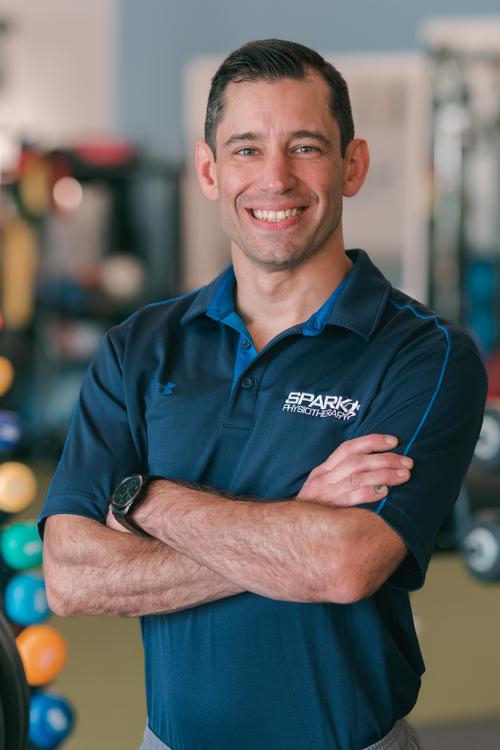K-Tape, a-Tape, or No-Tape? That Is the Question
Someone called me the ‘wizard of gauze’ once. I thought that was fitting, but I also needed to make sure that the patient knew that, at that moment, the tape was useful for him and useful for what he wanted to get back to doing, given the specific issue we were working to correct.
And there it is! The answer to every type of sports medicine-related question that I hear on the internet:
IT DEPENDS!
It’s not the answer people want to hear generally, but it’s always the right answer. In fact, the only time words like “always” and “never” really apply is when they refer to context. It always matters, and you can never ignore it.
So when do we tape? ![person with kinesio tape in Virginia]()
What Is K-Tape and What’s so Special About It?
Kinesio tape (aka KT Tape, Ktape) is a brand name for an elastic “sports tape” which boasts many supposed benefits, including:
- Improved healing
- Improved balance
- Improved proprioception
- Decreased swelling
- Faster return to sport
- Improved sport performance
- Managing inflammation
- And more dubious claims not listed here…
At this point, there are a dozen different companies selling elastic tape for various reasons and applications but for this post, we’ll bundle them all up into what we will call Ktape.
When Is K-Tape Useful? Why Is It Useful?
K-tape can be found in nearly any athletic training room, sports medicine treatment area, or outpatient physical therapy or chiropractic settings. It can be bought easily at any sporting goods store right beside good old-fashioned athletic tape.
Movement pros may use K-tape with good effect to cue a client to move in a specific manner and to SENSE the tape pulling on their skin to allow for self-correction into and out of different postures.
Imagine someone with good range of motion in the shoulder and neck but poor postural control. We might K-tape some portion of their posterior chain to “remind” them of when their dynamic posture has moved into a position that might exacerbate the client's condition. This is one of many useful approaches with K-tape.
Note, it does take some knowledge and practice to get the desired effect but nearly anyone can learn how to apply and use K-tape.
When Is K-Tape Less Effective?
Where Ktape, and all of its elastic tape friends, fall short are the places where athletic tape shines! But we’ll get to that later.
K-tape has NOT been shown to significantly and reliably:
- Improve healing
- Improve sport performance
- Decrease return to sport time frames
- Improve any strength or flexibility
- Effectively stabilize any joint
- There are too many dubious claims to list here…
But How Come I See All of These Amazing Athletes Wearing It?
There are two sides to this question and both are legitimate:
- “Plausible Advantage”: Professional athletes will always be on the lookout for ANYTHING that MIGHT give them the SLIGHTEST advantage over their opponents. If something as simple as applying some stretchy tape gave you even 1% of 1% advantage over your competition, you’d be silly not to do it; ESPECIALLY because using tape has almost NO unwanted effects. So why not apply it to everyone??
- Advertisement/Sponsorship: Athletes are billboards. They sell everything. And when the item they are selling can be used by the public and sold almost anywhere, well, that sounds like a winning financial formula. It has nothing to do with how effective Ktape is.
When Is Athletic Tape Useful? Why?
Athletic tape (A-tape) has been around forever. Its basic construction is an adhesive backing with cloth linen fabric. It is relatively stiff, moderately sticky, and is known to hold firmly for hours when applied properly.
There are many brands of athletic tape with varying stiffness, hold, etc that can be used for various applications. Not to mention much stiffer and stickier tapes that are almost exclusively the equipment of the sports medicine professionals, but can be found on the open market.
Where Ktape is meant to move, A-tape is meant to HOLD. The literature on ankle inversion sprains is vast and points to Atape as superior equipment for introducing stability where an injury has occurred.
A-tape is vastly more versatile than Ktape as well. An experienced clinician or athletic trainer can create a taping solution for nearly any instability problem.
Important to note that the next time you are checking out a game, count the athletes wearing some form of tape and tally up how many are strapped up with Atape, Ktape or nothing at all. That might give you a good idea of which direction to go if/when you could use some stability on an injured body part.
When Should I Skip Athletic Taping?
So now you know the difference between these two divergent tape materials. But does every injury need to be strapped up? Well, if you’re into the science of healing, like we are, then go ahead and tape. The literature on taping also interestingly points out that nearly ANY kind of strapping technique (including braces, neoprene sleeves, etc) do a great job at decreasing pain. And when we sense less pain, people tend to move more and better. And THIS is the way we can optimize healing.
So if you like Ktape, have at it.
If you think Atape is the way to go, just make sure you get a pro to teach you the best techniques.
And if you feel stable, your pain is subsiding, and your post-rehab strength and conditioning were on point, then get out there and make a difference. We’ll be here if you need us.

.png)




